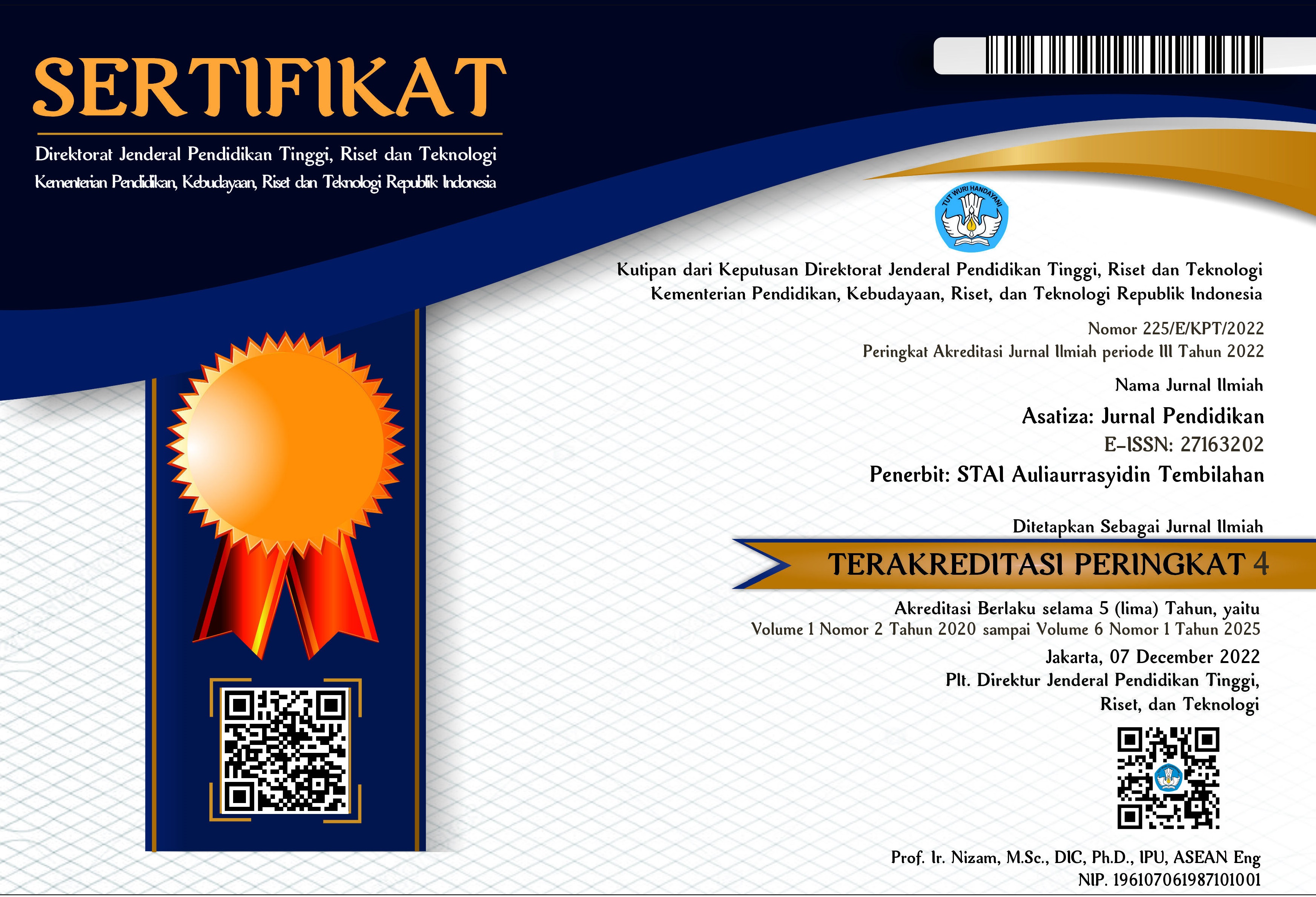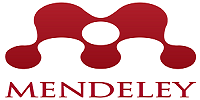| E-ISSN | P-ISSN |
Author Guidelines
- The article must be original, research-based, unpublished and not under review for possible publication in other journals.
- The article must be written either Indonesia or English.
- The article should be typed in MS Document format, Font 12 TNR, 1.15 Spacing on A4-paper size, 4.000-6.000 words (Including references, notes, and tables)
- The title of the article is written not more than 15 words.
- All submission must include 150 - 250 words abstract and 3-5 keywords. The abstract should contain the purposes, method, and findings of the study.
- Full name(s) of the author(s) must be stated, along with his/her/their affiliation and email address.
- All references must follow the APA latest style edition
- The manuscript must be in *.doc/.docx and sent to the journal system via online submission by creating an account in this Open Journal System (OJS) [click REGISTER] if you have not had any account yet; or click LOG IN if you have already had an account].
- All correspondences, information, and decisions for the submitted manuscripts are conducted through email was written in the manuscript and/or the emails used for the submission. The status of the manuscript can be checked in this OJS by logging into the journal website.
- Authors are suggested to present their articles in the section structure: Introduction - Method - Results and Discussion – (Acknowledment - optional) - Conclusion - References
- If you have submission queries, please contact [email protected], or visit contact in the journal website
- Article Format
TITLE
ft. 16 TNR sp. 1 -Max 15 Words
AUTHOR
Author1*, Author2 (ft. 11 TNR)
Corresponding E-Mail
AFILIATIONS
1 Department, Institution, State, Country (ft 10 TNR, sp. 1.15)
2 Department, Institution, State, Country (ft 10 TNR, sp. 1.15)
ABSTRACT
The abstract should be written clearly, concisely, and descriptively. It should contain research background, research aims, research methodology, result, discussion, and summary. It should be written in maximum 250 words. (ft. 11, TNR, sp. 1.15)
KEYWORDS
Maximum of 5 keywords relevant to research (separated by;)
A. INTRODUCTION (ft. 12 TNR, sp. 1,15 spacing before 0 pt, after 0 pt)
Start by introducing briefly and shotly about your research background, it contains maximum 15 paraghraps. Describing the State of The Art of previous reseach or relevant literature. Author must justify the novelty, the significance, or the contribution of his or her research by atleast 2 paraghraph. Before writing the purpose of the study, there must be a clear and explicit Gap Analysis or statement of the contribution of novelty (novelty statement), or a unique difference in research compared to previous studies, also in terms of whether the research is important or not, then the objectives are written. the research in this article is straightforward and clear. The introduction is about 2-3 pages long and typed in 1.15 spaces.
B. METHOD (ft. 12 TNR, sp. 1,15)
Includes exposure to the type of research, research subjects and participants, research instruments, data collection, methods and data analysis techniques.
Basically this section describes how the research was conducted. The main materials of this section are: (1) research design; (2) population and sample (research objectives, if any); (3) data collection techniques and instrument development; (4) and data analysis techniques. For research using tools and materials, it is necessary to write down the specifications of the tools and materials. Tool specifications describe the sophistication of the tools used while material specifications describe the types of materials used.
For qualitative research such as classroom action research, ethnography, phenomenology, case studies, and others, it is necessary to add the presence of researchers, research subjects, informants who helped along with ways to explore research data, location and length of research and a description of the checking. the validity of the research results.
It is best to avoid organizing writing into "sub-headings" in this section. However, if it cannot be avoided, the method of writing can be seen in the "Results and Discussion" section.C. RESULT AND DISCUSSION (ft. 12 TNR, sp. 1,15)
In this section, the authors present the results of their research. The points presented in this section are more emphasized on the scientific conclusions obtained than conveying a very detailed description of the myriad of data that is owned.
This section is the main section of the research article and is usually the longest section of the article. The research results presented in this section are “clean” results. Data analysis processes such as statistical calculations and hypothesis testing processes need not be presented. Only the results of the analysis and the results of hypothesis testing need to be reported. Tables and graphs can be used to clarify the presentation of research results verbally. Tables and charts should be commented on or discussed.
For qualitative research, the results section contains detailed sections in the form of sub-topics that are directly related to the research focus and categories.
The discussion in the article aims to: (1) answer the problem formulation and research questions; (2) shows how the findings were obtained; (3) interpret or interpret the findings; (4) linking the results of research findings with an established knowledge structure; and (5) generating new theories or modifying existing theories.
In answering problem formulations and research questions, the research results must be concluded explicitly. The interpretation of the findings is carried out using existing logic and theories. Findings in the form of realities in the field are integrated / linked with previous research results or with existing theories. For this purpose there must be a reference. In generating new theories, old theories can be confirmed or rejected, some may need to modify the old theories.
In an article, sometimes it is inevitable to organize the writing of research results into "sub-headings". The following is how to write the format of the organization, which shows how to write specific things that cannot be separated from an article.
Children First Subtitles
The picture rule is as follows if the image width matches the column width as shown in Figure 1 below. The images shown must have significance to support the results and discussion.
Second child subtitles
The picture rule is as follows if the image width matches the column width as shown in Figure 1 below. The images shown must have significance to support the results and discussion.
Picture1. Output Normal P-P Plot (TNR, ft. 10, center typed, sp 1)
Meanwhile, for the table, the table title is given above the table with the table number and description. If the table has a width beyond the width of the typing column, it can be displayed in the middle of the typing field, as shown in Table 1.
Table 1. (TNR, ft. 10, left aligned, sp 1)Table 1. Schedule of Learning Activities Implementation
If the table width exceeds the column width, it can span two columns.
Abbreviation (Acronym)
Common abbreviations such as STAD, PMRI, STEM, CGS, sc, dc, and rms do not need to be defined as the abbreviation. However, an acronym that is not very well known or an acronym made by the author needs to be described as its full length. For example: The MiKiR (Interactive, Collaborative, and Reflective Multimedia) learning model can be used to practice mastery of problem solving skills. Don't use abbreviations or acronyms in article titles, unless they can't be avoided.
Equation
You should write the equation in Times New Roman or Symbol font. If there are multiple equations, give them an equation number. The equation number should be in sequence, put it on the far right, namely (1), (2), and so on. Use signs to make equation writing more concise. Use an italic font for variables, bold for vectors.
Transcript
If loading a transcript, the writing format is as follows:
Teacher: Well, iki is simplified to iki. Oh, how come it's not filled yet? This is filled in first. You don't just play pretend. Manut hint, 3 piye lipet? Ngono.
Student: Is that what it is? 1. (While folding the paper)
Teacher: Hey.
Students: 2. (While folding the paper again)
Teacher: Well, your creations will finally be confused.
One of the characteristics of scientific articles is to present the ideas of others to strengthen and enrich the ideas of the author. Ideas which have been previously expressed by others are referred to (referenced), and the sources of reference are included in the Reference.
Reference must be complete and in accordance with the references presented in the body of the article. That is, sources written in Reference are actually referenced in the body of the article using APA 6th style. On the contrary, all references that have been mentioned in the article must be included in the Reference. To show the quality of a scientific article, a sufficient list should be included in the Reference. References are arranged alphabetically and the way of writing is adjusted to the rules set out in the journal.D. CONCLUSION (ft. 12 TNR, sp. 1,15)
The results of this study indicate that students who learn mathematics with the PMR approach get a significant increase in learning independence, in terms of the overall sample and at low level schools, while students who study mathematics with the PB approach do not experience a significant increase in learning independence, both in terms of the overall sample. as well as by school level. Furthermore, the increase in students' learning independence in mathematics on the aspect of cognitive strategies for students learning mathematics with the PMR approach was significantly higher than for students learning mathematics through the PB approach. The results of this study prove that the PMR approach is relatively superior to the PB approach in terms of increasing students' learning independence in mathematics.
Therefore, researchers suggest that teachers can use the PMR approach as an alternative approach to learning mathematics to improve students' learning independence in mathematics, especially in the aspects of cognitive strategies, but this approach should be applied for a longer time so that students receive adequate training so that they get an increase. higher learning independence.REFERENCES (ft. 12 TNR, sp. 1,15) BASED ON (APA 6th Style, Use Mendeley Application Reference Manager)
References must be dominated by primary sources in the form of scientific journal articles published in the last 10 years. Minimum references 15. Minimum 80% of references come from primary literature / scientific journals.
Reference is a list of written works that the author reads in preparing his article and is then used as a reference. In scientific articles, references must exist as a complement to references and guidance on reference sources. Reference writing follows the rules in this Manual, namely APA 6th style. Reference writing is mandatory using automatic citation applications (Mendeley, Zotero, and etc.).Follow (APA 6th Style, Use Mendeley Application Reference Manager)
Examples:
Adrelia, D. I., Kurniawati, V., & Prahmana, R. C. I. (2015).Permainan bom angka dalam konsep kelipatan persekutuan terkecil untuk anak sekolah dasar. Jurnal Elemen, 1(1), 25-35.(Artikel Jurnal tidak ber DOI)
Axford, J.C. (2008). What constitutes success in Pacific Island community conserved areas? (Doctoral dissertation, University of Queensland, Brisbane, Australia). Retrievedmfrommhttp://espace.library.uq.edu.au/view/UQ:158747(Tesis diperoleh dari Website)
Baker, F. M., & Lightfoot, O. B. (2013).Psychiatric care of ethnic elders. In A. C. Gaw (Ed.), Culture, ethnicity, and mental illness (pp. 517-552). Washington, DC: American Psychiatric Press.(Bab dalam buku yang di edit versi cetak)
Freudenthal, H. (2012). Revisiting mathematics education. New York: Kluwer Academic Publisher. (Buku)
Herculano-Houzel, S., Collins, C. E., Wong, P., Kaas, J. H. & Lent, R. (2008).The basic nonuniformity of the cerebral cortex.Proceedings of the National Academy of Sciences, 105, 12593-12598. doi:10.1073/pnas.0805417105(Prosiding Online Regular)
Iacono, W. G. (2008). Polygraph testing. In E. Borgida & S. T. Fiske (Eds.), Beyond common sense: Psychological science in the courtroom (pp. 219-235). doi: 10.1002/9780470696422(Bab dari buku elektronik diedit dengan DOI)
Osman, M. (2010).Controlling uncertainty: A review of human behavior in complex dynamic environments.Psychological Bulletin, 136(1), 65-86. doi: 10.1037/a0017815(Artikel Jurnal ber DOI)
Rahman, M. (2013).Using authentic materials in the writing classes: Tertiary level scenario.(Unpublished master's thesis).BRAC University, Mohakhali, Dhaka, Bangladesh.(Tesis yang tidak dipublikasikan)
Scott, D. (2015). Colonial governmentality.In J. X. Inda (Ed.), Anthropologies of modernity (pp. 21-49). Retrieved from http://www3.interscience.wiley.com/cgi-bin/bookhome/117909832(Bab dari buku elektronik yang diedit tanpa DOI)
NOTE: It is suggested the use of a reference manager, such as: Mendeley
The Word version of this guideline is available for download here.








2.png)



